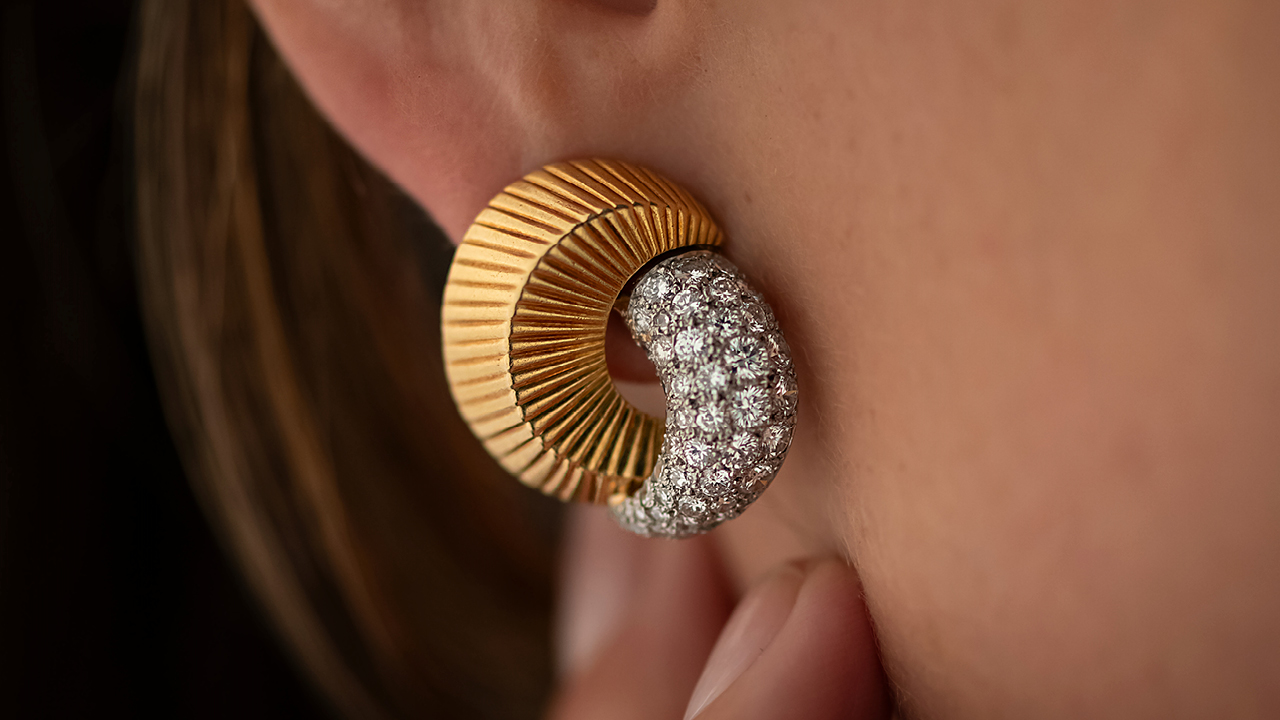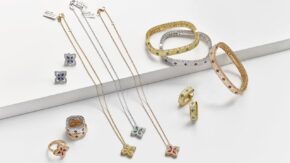In the past few years, the Retro period, which ran from the late 1930s through the early ’50s, has witnessed a revival thanks to a number of growing jewelry trends — specifically a penchant for yellow and rose gold, bolder statement pieces, three-dimensional designs, and big colorful stones with enamel highlights.
The years before, during, and after World War II challenged jewelers to invent new techniques and work with alternative materials, leading to a creative outpouring of motifs and silhouettes ranging from naturalistic to geometric styles.
A “visually striking [appearance] and ease of wear has led to the renewed popularity of Retro jewelry among collectors in recent years,” reports Ben Macklowe, president of New York-based antique and vintage shop Macklowe Gallery. “Yellow gold, a prevalent material in these pieces, seamlessly integrates into daily attire, allowing for versatile dressing options. This adaptability sets it apart from other time periods.”
Peter Schaffer agrees. “The bold and futuristic designs of the war and postwar years played with weight and scale, shaping metals to be larger and rounded and more three-dimensional,” says the co-owner of New York jeweler A La Vieille Russie. “There was also enthusiastic use of colored gemstones, all of which are alluring to a new generation of jewelry collectors and enthusiasts.”
Affordability played a role then as well as now, notes Elizabeth Doyle, co-owner of antique jeweler Doyle & Doyle in New York. “The jewelers of the day created bold, glamorous looks with limited resources at accessible prices. These designs still provide strong, impactful pieces for today’s collectors at a more affordable level than pieces that rely heavily on diamonds and fine colored stones for their designs.”
The bold and the versatile
When we talk about the defining pieces of the era, says Macklowe, “it’s important to understand that there were three distinctive styles,” spanning the prewar period, the war itself, and the postwar years.
Prominent silhouettes, details and motifs included curvy lines, circles, asymmetry and volume.
“The most prevalent pieces during all three periods include convertible styles — necklaces that turn into bracelets or detach to form earrings,” he continues. “Bold semiprecious stones including aquamarine, topaz, citrine and amethyst replaced precious gems as [the latter] became scarce in Europe. Prominent silhouettes, details and motifs included curvy lines, circles, asymmetry and volume. Tank, tread [and] belt bracelets, [as well as] hidden watches, were also a sign of the times. Notable pieces like the Van Cleef & Arpels zip necklace continued the Retro style’s legacy, along with [designs like] tubogas [and Van Cleef’s] Ludo and mystery-set stones, [which] had begun before the war.”
Doyle affirms the popularity of transformables like double clip brooches, which she says are still desirable today. “They could be worn as one larger piece, or they could be separated into two matching clips to be worn in numerous ways. Large scrolling clip earrings set with colored stones are also very representative of the time.”

Putting it all together
One aspect of Retro’s appeal is that it meshes well with more recent periods. “For us, it’s the youthful, fashion-savvy collectors who gravitate toward Retro jewelry,” remarks Doyle. “They also tend to like bold gold jewelry from other eras, such as the chunky gold jewelry from the ’80s — particularly hoops and chains, as they mix together well and offer a look that can be part of any daily rotation.”
Schaffer notes collectors’ appreciation for “the boldness and less delicate nature of the designs [compared to those of] the 19th and earlier-20th centuries. Although each period has its unique charm, the styles of Retro work with the widest range of modern fashion trends for any time of day.”

Burgeoning value
At one time, Retro was the affordable choice among collectors, but all three jewelers agree that prices are
going up.
“This period has recently seen an increase in prices, especially for sought-after styles like tank bracelets, which are currently in high demand,” says Macklowe. “The prices of Retro jewelry can vary widely depending on factors such as the rarity of the design, the quality of materials, and the presence of significant motifs. While the use of less-expensive materials during the war years may have initially influenced prices, the growing demand for Retro jewelry in recent times has contributed to its appreciation in value.”
Design of the times
The period between the late 1930s and early 1950s saw major changes in fine jewelry. From 1935 to ’37, at the end of the Art Deco movement, jewelers explored new takes on nature-inspired forms and created pieces we now classify as statement jewelry. The prewar years focused on ornamentation and engineering: The bigger and bolder, the better, but designers developed techniques so that no piece felt too heavy to wear.
Still, “jewelry faced early challenges due to wartime constraints,” relates Ben Macklowe of Macklowe Gallery. The industry “transitioned into reworking raw materials supplied by customers. Gold became the primary material. The trade of gold was banned in France; clients had to provide their own, with the Banque de France deducting 20% of the melt value.”
Platinum was forbidden to sell, as it was reserved for the war effort. Resourceful jewelers used a low-karat gold with various alloys, which manifested as different colors in a single piece. The exuberant prewar pieces became simpler and more austere as women began to work in the factories. The ultra-wide, three-dimensional yet lightweight tread and tank bracelets, which took inspiration from the treads in factories and wartime tanks, became the quintessential jewels of this period.
So did emblematic designs at the major houses. Cartier’s famous 1942 Caged Bird brooch, symbolizing occupied France, was on prominent display in the maison’s Rue de la Paix shop window. Van Cleef & Arpels, Boucheron, and Mauboussin all crafted patriotic pieces that people could wear proudly.

Jewelers often used synthetic rubies and sapphires instead of real gems, and set huge semiprecious stones into rings and necklace centerpieces. The postwar years featured animal and floral motifs, as well as fabric-like gold designs in the form of bows, knots, ribbons and tassels. Semiprecious stones remained popular, and charms became a way to celebrate and commemorate any occasion.
Today, all of these looks are once again on trend.
Main image: Cartier swirl clip earrings in 18-karat gold and platinum with diamond pavé, London, circa 1950. (A La Vieille Russie)
This article is from the November-December 2023 issue of Rapaport Magazine. View other articles here.
Stay up to date by signing up for our diamond and jewelry industry news and analysis.



